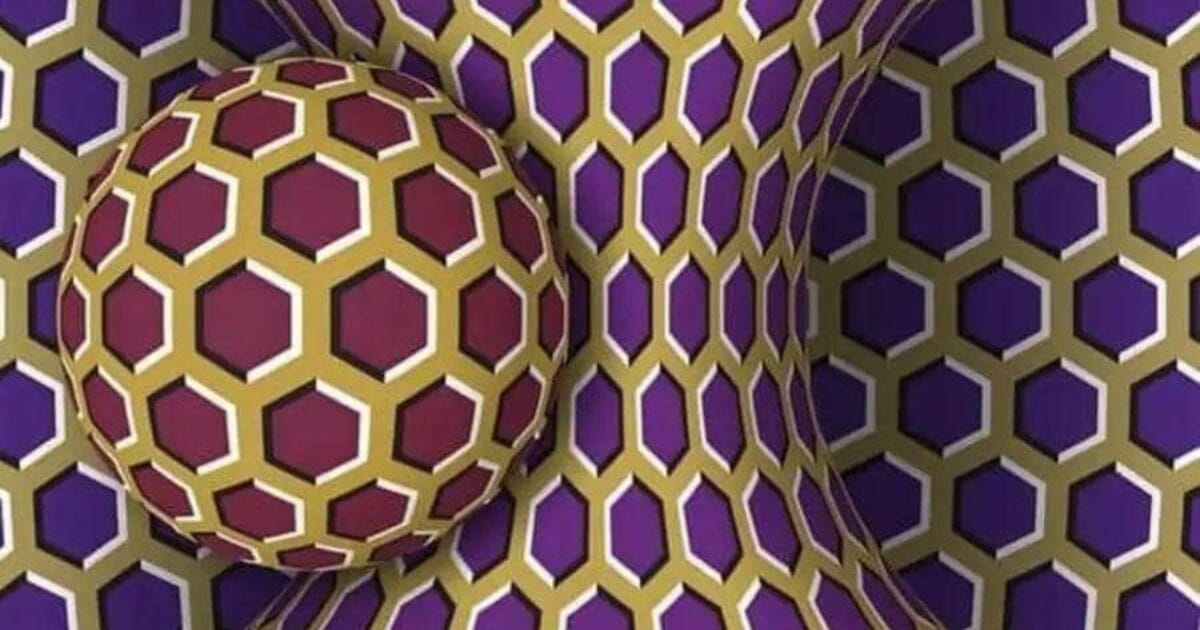Pictures of optical illusions are widespread on the Internet, which neurologists allegedly developed for self-diagnosis of stress levels. We decided to find out if this is so.
"Ball and Honeycomb"
This optical illusion is usually distributed with the following caption: “This image was created by a Japanese neurologist. It remains motionless when you are calm. It begins to move when you experience a little inner agitation. Under extreme stress, it moves like a carousel.” Examples of such posts can be found in Telegram, Facebook and on other platforms.
Most viral posts do not indicate which scientist developed this unusual stress test, which university he works at, or which scientific journal he presented his results in. The authors of some publications are only clarify, that this is the discovery of the Japanese psychotherapist (according to another version, neurologist) Yamamoto Hashima. “Checked” was unable to find a specialist with that name in the scientific citation database Google Scholar, the academic library JStor, and similar resources.
Fact checkers from the Lead Stories project found out, that for the first time a picture supposedly helps determine the level of stress, was published in September 2016 on Twitter (now X). It turned out that it was created not by a Japanese psychotherapist or neurologist, but by Ukrainian designer Yuri Perepadya. His tweet was accompanied by hashtags like #art and #illustration, as well as link to the Shutterstock photo bank, where other similar works by the author are available.
“I drew this optical illusion in Adobe Illustrator on September 26, 2016. To create it, I used the Akioshi Kitaoka effect - this is a white and black outline on a colored background, which moves the focus of vision and it seems to a person that the details of the image are moving. Japanese psychotherapist Yamamoto Hashima has nothing to do with this picture. Moreover, Yamamoto Hashima does not actually exist. Google it just for fun,” wrote Swings on Instagram in 2018, when the picture had been circulating on social networks for a year under the guise of a rapid test for stress levels developed in Japan.
"Snakes"
Akioshi Kitaoka, whom Perepadya mentioned in his post, appears in numerous publications by social network users as the author of other pictures that allow one to determine the level of fatigue. The most popular of them is with circles that look like snakes. “This illusion was invented by the Japanese psychiatrist Akioshi Kitaoka. He argues that the illusion is motionless for calm, balanced and rested people. If the illusion is actively moving, then you need rest and sleep for eight hours. Well, if the illusion moves very, very quickly, then you urgently need rest in the hospital... So, let’s check ourselves and, if anything, begin to rest,” it says post on Facebook, which has been shared more than 1,000 times. In March 2024, this picture with a similar caption published in his Telegram channel, Advisor to the Minister of Internal Affairs of Ukraine Anton Gerashchenko (125,000 views at the time of writing this analysis). Another image supposedly created by Kitaoka to test his stress levels, a few years ago became popular in X. On "Zen" there is a whole selection works of the Japanese, which supposedly help determine the psychological state of the patient.
Kitaoka, unlike the fictional Yamamoto Hashima, is actually a psychologist, professor Ritsumeikan University in Osaka. He has been working with optical illusions since the 1990s: both as a scientist studying the features of visual perception and as an artist (he has published more than ten optical illusion albums, participated in exhibitions, and one of his works was even used in the design of Lady Gaga’s album Artpop).
How explains Kitaoka himself, his works show the mechanism of the illusion of peripheral drift. If a person focuses his gaze on an element of the image, other fragments of it, visible in peripheral vision, appear to be moving, although in fact they are also static. The illusion most often occurs when a picture consists of areas with different brightness levels, such as black and dark gray or white and light gray. It is enhanced if the contours of the image are curved rather than straight.
This is the principle behind the “snake” illusion, which is popular among social media users as a quick test for fatigue levels. Kitaoka created This image is back in 2003.
Along with claims that these illusions help determine stress levels, Kitaoka's work has been circulating since at least the mid-2000s. On his page on the university website, the professor even collects a collection of similar publications. In 2018, on his verified Twitter page, Kitaoka wrote: “Visual illusions have nothing to do with stress.”
Thus, the illusions mentioned in this section were indeed created by a Japanese psychologist, but he never claimed that they could be used to determine the level of stress or fatigue.
Cover illustration: Yuri Perepadya
Read on topic:
- Is it true that watching cute animal videos helps reduce stress?
- Is it true that scientists have learned to convert human stress into electricity?
If you find a spelling or grammatical error, please let us know by highlighting the error text and clicking Ctrl+Enter.






